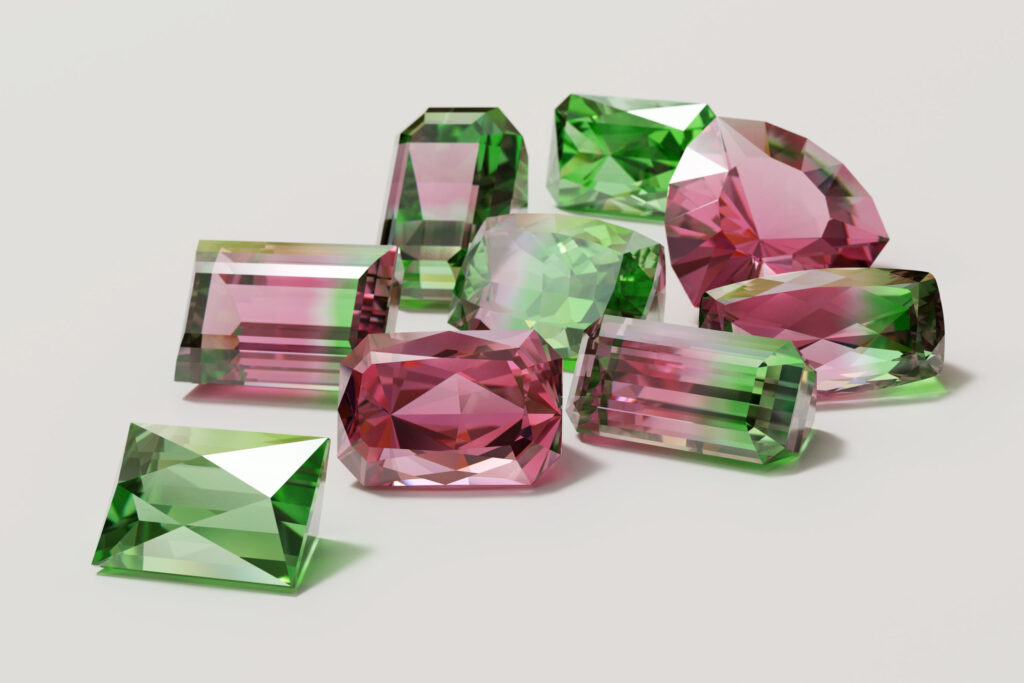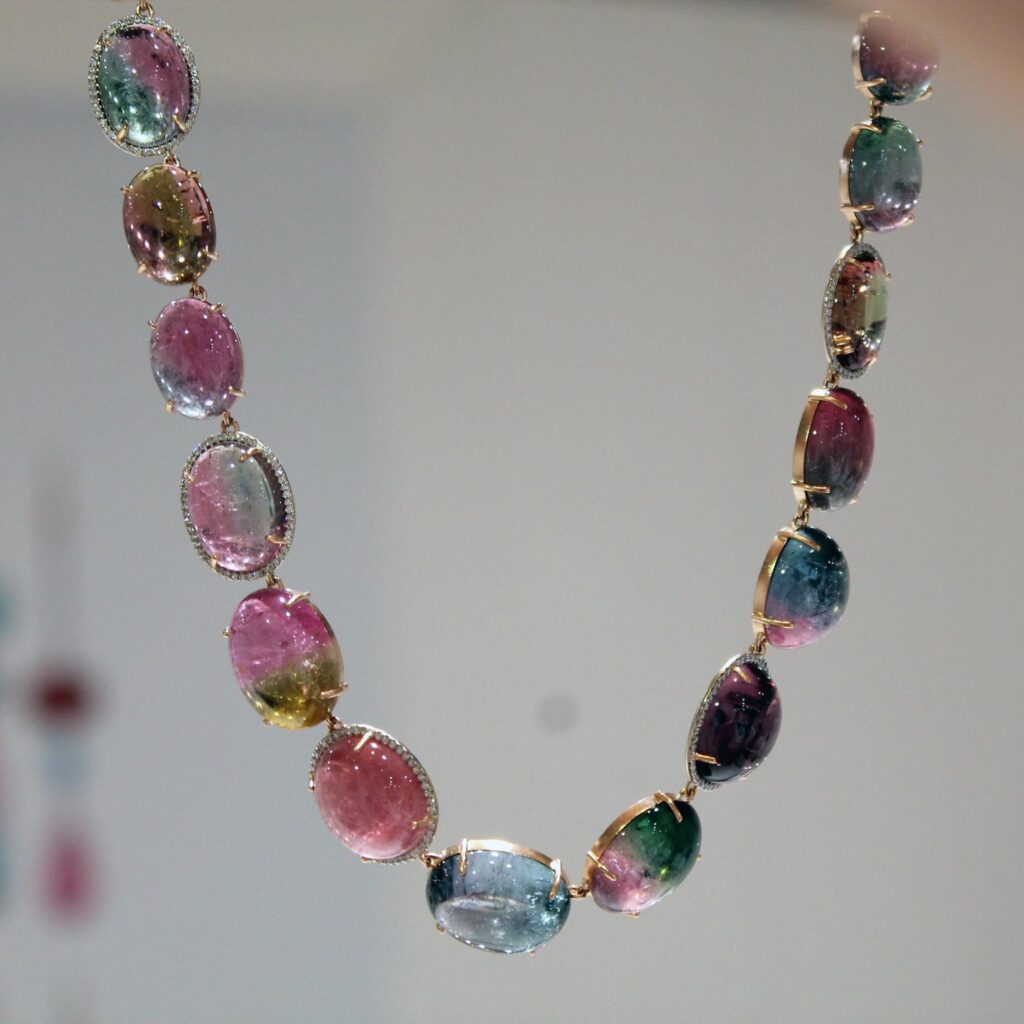
Introduction:
Tourmaline, a gemstone of mesmerizing beauty and mystical properties, has captured the hearts of gem enthusiasts and spiritual seekers alike. Beyond its stunning appearance, tourmaline boasts a rich history, a spectrum of colors, and purported metaphysical benefits. Join us on a journey as we explore the enchanting world of tourmaline and discover why this gemstone is more than just a feast for the eyes.
The History of Tourmaline:

The name “tourmaline” is derived from the Sinhalese word “turamali,” which means “stone with mixed colors.” Throughout history, tourmaline has been revered in various cultures for its alleged protective and healing properties. Ancient Egyptians believed that tourmaline acquired its vibrant hues as it journeyed through a rainbow, collecting all the colors along the way. It was also favored by the Romans, who believed the gemstone could inspire artistic expression.
A Kaleidoscope of Colors:
One of tourmaline’s most captivating features is its wide range of colors. From the deep green of the verdant forests to the vibrant pinks resembling the hues of a summer sunset, tourmaline offers a kaleidoscope of possibilities. This incredible variety has led to specific names for different color variations, such as rubellite for red and pink tourmaline, indicolite for blue tourmaline, and watermelon tourmaline for stones exhibiting a green-to-pink gradient.
Metaphysical Properties:
Beyond its aesthetic allure, tourmaline is often associated with various metaphysical properties. Many believe it possesses protective qualities, shielding the wearer from negative energies and promoting a sense of balance. Black tourmaline, in particular, is thought to absorb and repel negative energy, making it a popular choice for those seeking grounding and protection.
Tourmaline in Jewelry:

Tourmaline’s versatility makes it a favorite among jewelry designers. Its wide range of colors allows for unique and creative designs, whether set in a classic solitaire ring or incorporated into intricate pendant designs. The gemstone’s durability and brilliance make it an excellent choice for everyday wear, ensuring that its beauty can be enjoyed for generations to come.
Caring for Your Tourmaline Jewelry:
To preserve the beauty of your tourmaline jewelry, it’s essential to take proper care. Minimize the gemstone’s contact with abrasive chemicals, extreme temperature conditions, and prolonged exposure to direct sunlight to ensure its long-lasting beauty and integrity. Regular cleaning with a mild soap and water solution can help maintain its luster. Consulting with a professional jeweler for periodic inspections and maintenance will ensure that your tourmaline jewelry remains as stunning as the day you acquired it.
Conclusion:
Tourmaline, with its fascinating history, captivating colors, and alleged metaphysical properties, stands as a gemstone that transcends mere aesthetics. Whether you’re drawn to its beauty or intrigued by its mystical lore, tourmaline continues to enchant and inspire those who have the privilege of wearing or admiring this remarkable gem. As we delve deeper into the world of gemstones, tourmaline undoubtedly shines as a true gem among gems.
The Geological Marvel:
Delving into the geological aspects of tourmaline unveils a marvel of nature. Comprising a complex crystalline structure, tourmaline is a boron silicate mineral with elements like aluminum, iron, magnesium, sodium, lithium, or potassium incorporated into its composition. This intricate blend of elements contributes to the gem’s unique colors and characteristics. The presence of trace elements can influence whether the tourmaline appears more transparent or opaque, further enhancing its individuality.
Mining and Sources:
Tourmaline is mined in various locations worldwide, and each source yields distinct variations of the gemstone. Notable deposits include Brazil, Afghanistan, Nigeria, Mozambique, and the United States. The diversity in geological environments results in tourmaline gems with varying colors, sizes, and optical properties. The global availability of tourmaline ensures that enthusiasts can explore a spectrum of options when selecting their preferred gem.
Unraveling the Color Mysteries:
The enchanting array of tourmaline colors stems from its unique crystal structure. Iron-rich tourmalines can display shades of black and brown, while manganese contributes to red and pink hues. The presence of lithium or aluminum results in greens and blues, creating a mesmerizing palette for gem aficionados. Understanding the geological processes that govern these colorations adds another layer of appreciation for the complexity of tourmaline.
Popular Varieties and Their Characteristics:
Tourmaline’s popularity extends to various color varieties, each with its distinct characteristics. Here are some notable types:
Rubellite: Ranging from pink to deep red, rubellite is cherished for its vibrant hues. Some rubellites display a captivating neon glow under certain lighting conditions.
Indicolite: This blue variety of tourmaline, often reminiscent of serene ocean waters, is prized for its calming and soothing appearance.
Watermelon Tourmaline: Exhibiting a unique bicolor pattern resembling a watermelon’s cross-section, this variety seamlessly blends green and pink hues.
Paraíba Tourmaline: Renowned for its electric blue to green shades, Paraíba tourmaline is among the rarest and most valuable varieties, often sourced from Brazil.
Schrol: Black tourmaline, also known as schorl, is revered for its protective properties and is commonly used in metaphysical practices.
Sustainability and Ethical Practices:
As with any precious resource, the ethical sourcing of tourmaline is gaining significance in the jewelry industry. Responsible mining practices, fair labor conditions, and environmental considerations are becoming crucial factors for conscientious consumers. By supporting brands committed to ethical practices, enthusiasts can ensure that their tourmaline jewelry comes with a positive impact on both people and the planet.
Innovations in Jewelry Design:
The versatility of tourmaline extends beyond its varied colors to the innovative designs it inspires. Jewelry designers are continually pushing boundaries, creating avant-garde pieces that showcase the gemstone’s beauty in unexpected ways. From asymmetrical settings to unconventional cuts, tourmaline’s adaptability fuels a dynamic and ever-evolving landscape in the world of jewelry design.
In conclusion, tourmaline is not merely a gemstone; it is a geological masterpiece that weaves together history, color, and mystique. Whether cherished for its aesthetic appeal, metaphysical properties, or geological intricacies, tourmaline stands as a testament to the wonders that Earth’s treasures can hold. As we continue to unearth the secrets of this gemstone, the allure of tourmaline is bound to endure, captivating generations to come.
Tourmaline’s Journey Through Time and Culture:
Embarking on a journey through the annals of time and various cultures, we witness the enduring fascination with tourmaline. Historically, this gemstone has been more than a mere adornment; it has played a significant role in cultural beliefs and practices. Ancient civilizations held diverse beliefs about the stone’s mystical properties, considering it a talisman for protection and a conduit for spiritual energies. From the revered talismans of ancient shamans to the intricate jewelry of the Renaissance, tourmaline has left an indelible mark on the tapestry of human history.
Modern Resurgence and Celebrity Allure:
While tourmaline has a rich history, its allure continues to captivate contemporary audiences. A resurgence in popularity can be attributed to its versatility, with jewelry designers and fashionistas alike embracing its vibrant hues in modern designs. The red carpet has witnessed the dazzling presence of tourmaline in the form of exquisite jewelry adorning celebrities, adding a touch of glamour and sophistication to high-profile events. The gem’s resurgence in the mainstream attests to its timeless beauty and ability to seamlessly blend tradition with contemporary style.
Tourmaline as a Symbol of Connection:
Beyond its physical attributes, tourmaline carries a symbolic weight, often seen as a representation of connection and unity. Its multifaceted nature mirrors the diversity of human experiences and emotions. In relationships, tourmaline is sometimes exchanged as a token of affection, symbolizing the unique journey that two individuals embark on together. Its wide array of colors offers a metaphor for the kaleidoscope of emotions that color our lives, making it a meaningful choice for those seeking more than just a beautiful gem.
Tourmaline in Alternative Therapies:
For those drawn to holistic healing practices, tourmaline has found a place in alternative therapies. Some believe that the gemstone’s energy can align with the body’s natural vibrations, promoting physical and emotional well-being. Whether incorporated into meditation practices or worn as part of energy-balancing jewelry, tourmaline has become a staple in the realm of metaphysical wellness.
Environmental Impact and Responsible Sourcing:
As awareness grows regarding the environmental impact of gemstone mining, responsible sourcing practices have become a focal point for both consumers and the industry. Ethical considerations, fair labor practices, and environmental sustainability are paramount in ensuring that tourmaline, and other precious gems, are sourced with care and responsibility. Supporting brands committed to these principles ensures that the beauty of tourmaline doesn’t come at the cost of environmental degradation or exploitation.
Looking Ahead: Tourmaline in the Future:
As we stand at the crossroads of tradition and innovation, tourmaline continues to evolve and adapt. Advances in gemstone treatments and cutting techniques promise new possibilities for showcasing the gem’s inherent beauty. Additionally, continued efforts toward ethical sourcing and sustainable practices will likely shape the future narrative of tourmaline in the jewelry industry. Whether it’s cherished for its historical significance, dazzling aesthetics, or holistic properties, tourmaline’s journey is far from over—it’s a gem that stands the test of time and trends alike.


